The Instant Water Heater Market is estimated to be valued at USD 13973.9 million in 2025 and is projected to reach USD 21909.7 million by 2035, registering a compound annual growth rate (CAGR) of 4.6% over the forecast period.
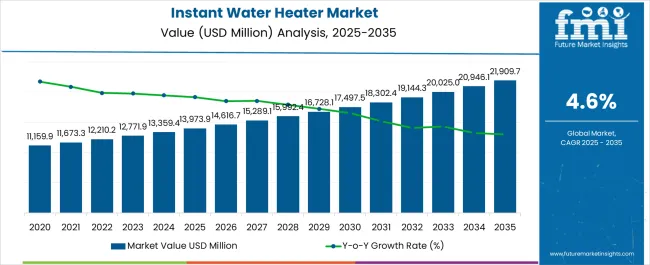
| Metric | Value |
|---|---|
| Instant Water Heater Market Estimated Value in (2025 E) | USD 13973.9 million |
| Instant Water Heater Market Forecast Value in (2035 F) | USD 21909.7 million |
| Forecast CAGR (2025 to 2035) | 4.6% |
The instant water heater market is witnessing robust growth, driven by increasing urbanization, rising disposable incomes, and growing preference for energy-efficient appliances. Compact design and rapid heating capabilities have made instant water heaters a popular choice for modern households with space constraints and on-demand hot water requirements.
Manufacturers are focusing on product innovation, including advanced safety features, smart controls, and enhanced energy efficiency, aligning with evolving consumer expectations. Government energy conservation initiatives and rising electricity penetration in emerging economies further support adoption.
The market outlook is strengthened by rising replacement demand in developed regions and first-time purchases in emerging markets. With growing emphasis on convenience, efficiency, and sustainability, instant water heaters are poised to maintain a strong growth trajectory globally.
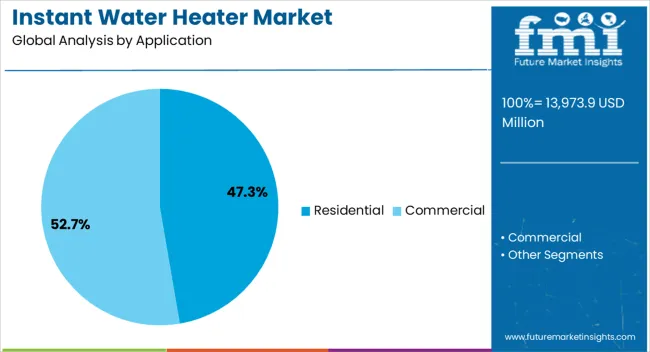
The residential segment leads the application category with approximately 47.30% share, supported by strong household demand for compact and efficient water heating solutions. Rising urban housing development and the trend toward nuclear family structures have amplified demand for instant water heaters.
The segment benefits from consumer preference for cost-effective and space-saving appliances that align with modern living standards. Adoption is reinforced by increasing awareness of energy-efficient devices, driving replacement of traditional storage heaters.
The availability of multiple capacity options and affordable pricing has further fueled household penetration. With rising housing investments and lifestyle upgrades, the residential segment is expected to remain the dominant contributor to market growth in the near term.
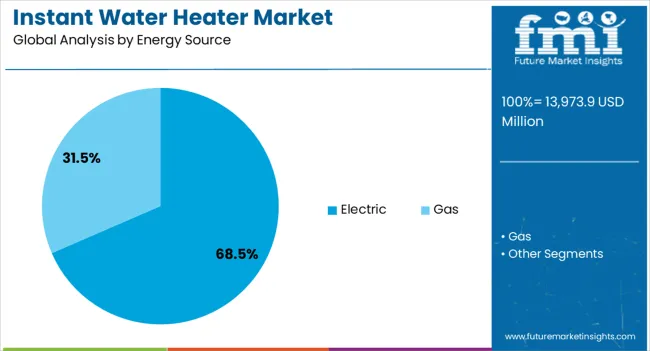
The electric segment dominates the energy source category with approximately 68.50% share, reflecting its convenience, widespread availability, and compatibility with modern residential and commercial infrastructure. Electric instant water heaters provide quick heating with lower maintenance compared to gas alternatives, making them the preferred choice in urban households.
The segment is supported by ongoing improvements in energy efficiency and safety standards, including features such as automatic shut-off and leakage protection. Expansion of reliable electricity access in emerging economies has significantly boosted adoption.
With increasing regulatory emphasis on energy conservation and continued technological innovations, the electric segment is anticipated to retain its leading position in the forecast period.
| Attributes | Details |
|---|---|
| Historical Market Size (2020) | USD 11,777.9 million |
| Instant Water Heater Market Size (2025) | USD 13,359.4 million |
| HCAGR (2020 to 2025) | 3.20% |
The instant water heater market size expanded at a 3.20% CAGR from 2020 to 2025. Customers' growing consciousness of energy efficiency and desire to reduce utility expenses have prompted the quest for more economical water heating solutions. The energy-efficient instant water heaters, often referred to as tankless water heaters, eliminate the continual loss of energy associated with conventional tank water heaters by heating water only when needed. Everyday convenience and on-demand services are becoming increasingly important to consumers. Without having to wait for a storage tank to warm up, instant water heaters deliver hot water virtually quickly. This prompt adaptation is consistent with the current lifestyle, where convenience plays a big role in consumer decisions.
Technological advancements have significantly aided the expansion of the market in the design and operation of instant water heaters. Smart controls, programmable settings, and connection to smart home systems are examples of advanced technologies that have improved user experience and drawn in tech-savvy customers. Compact water heaters are popular among customers with limited space, such as those living in flats or smaller residences, because of their design. In addition, producers have concentrated on producing visually attractive designs that qualify fast water heaters for installations visible in bathrooms and kitchens.
The demand for instant water heaters is anticipated to surge at a 4.60% CAGR through 2035. Enhanced water quality control capabilities are expected to be included in future rapid water heaters. Meeting rising customer concerns about water quality could entail more advanced filtration, purification, and monitoring systems to guarantee not just hot water supply but also water safety. Additionally, adaptive control systems and predictive maintenance for instant water heaters could benefit from AI and ML technology. Intelligent algorithms have the potential to enhance operational efficiency and dependability by examining consumption trends, identifying irregularities, and optimizing performance.
| Trends |
|
|---|---|
| Opportunities |
|
| Challenges |
|
| Top Application | Residential |
|---|---|
| Value Share (2025) | 70.20% |
The appeal of instant water heaters' in residential settings is partly attributed to their incorporation into smart home ecosystems. Through voice-activated assistants or smartphone applications, homeowners can remotely manage and monitor these gadgets, providing a level of convenience and keeping up with the rapidly expanding trend of smart home technology. The energy-efficient nature of instantaneous water heaters is well-liked by budget-conscious customers. Instant water heaters heat water just when it is needed, as opposed to conventional tank water heaters that heat and store water continually. As a result, there is a decrease in energy use, which lowers utility costs and saves household money over time.
| Top Energy Source | Electric |
|---|---|
| Value Share (2025) | 73.60% |
The competitiveness of the market and improvements in manufacturing techniques have reduced the cost of electric instant water heaters. These devices' affordable prices have opened up access to a wider spectrum of customers, which has aided in their widespread use. Instantaneous water heaters that run on electricity heat water quickly and on-demand, giving homeowners access to hot water right away. Because there is no storage tank, there is no waiting for the water to get to the right temperature, which is in line with contemporary lifestyles that value convenience. In the upcoming years, it is anticipated that the demand for electric tankless water heaters would soar.
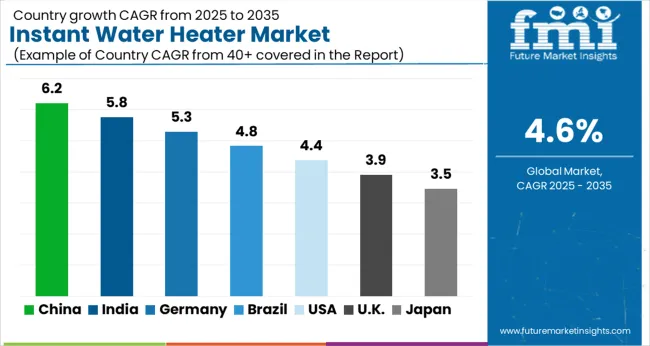
The demand for instant water heaters in the United States is projected to rise at a 3.20% CAGR through 2035. The pent-up demand is one aspect of the replacement market that is frequently disregarded. As homeowners look for more contemporary and effective options, manufacturers have a chance to capitalize on aging water heating systems. In a dynamic climate where instant water heaters are increasingly viewed as feasible improvements, the industry is expanding in part due to the need to replace outdated water heaters.
The instant water heater market in Canada is predicted to surge at a 4.20% CAGR through 2035. The regulatory environment is changing, with a focus on sustainable practices and energy efficiency regulations. This has a substantial impact on the growth of the Canadian market. Instant water heaters, which are well-known for their energy efficiency and ability to heat water on demand, play a crucial role in fulfilling compliance requirements as the country strives to satisfy increasingly strict environmental standards. Manufacturers are profiting from this rise in demand generated by regulations by actively marketing their products as compliant and eco-friendly.
The instant water heater market size in China is estimated to develop at a 4.60% CAGR through 2035. The instantaneous water heater market is growing dramatically as a result of China's explosive growth in e-commerce and online retail penetration. Manufacturers are taking advantage of the large digital customer base by using online channels for sales and distribution. Reaching and gaining a larger market share requires the use of e-commerce tactics, such as online promotions, special offers, and effective logistics.
The instant water heater market in India is anticipated to rise at a 6.10% CAGR through 2035. The rapid development of India's real estate sector and infrastructure stimulates the demand for instant water heaters. Strategically promoting their goods as contemporary, energy-efficient, and space-saving options for new residential buildings is how manufacturers are working with construction companies and real estate developers. This suits the tastes of those looking for modern conveniences in their homes.
The sales of instant water heaters in Australia are predicted to surge at a 5.30% CAGR through 2035. The growing use of solar energy in Australia coincides with the rise of the market for instantaneous water heaters. Solar-compatible instant water heater manufacturers leverage the country's green living tendencies. Products that smoothly connect with solar panels and encourage energy-efficient heating are strategically positioned to appeal to environmentally concerned consumers looking for sustainable home solutions.
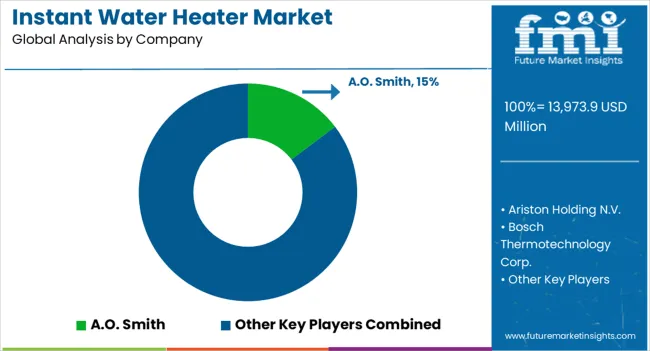
A mix of established firms, new startups, and global rivals defines the instant water heater market's competitive landscape. Companies' strategies are defined by the interaction of elements such as brand recognition, technical innovation, cost competitiveness, global market growth, regulatory compliance, and customer experience as they attempt to protect their positions and prosper in this dynamic market.
Recent Developments
The global instant water heater market is estimated to be valued at USD 13,973.9 million in 2025.
The market size for the instant water heater market is projected to reach USD 21,909.7 million by 2035.
The instant water heater market is expected to grow at a 4.6% CAGR between 2025 and 2035.
The key product types in instant water heater market are residential, commercial, _college/university, _offices, _government/military and _others.
In terms of energy source, electric segment to command 68.5% share in the instant water heater market in 2025.






Full Research Suite comprises of:
Market outlook & trends analysis
Interviews & case studies
Strategic recommendations
Vendor profiles & capabilities analysis
5-year forecasts
8 regions and 60+ country-level data splits
Market segment data splits
12 months of continuous data updates
DELIVERED AS:
PDF EXCEL ONLINE
Instant Dry Yeast Market Size and Share Forecast Outlook 2025 to 2035
Instant Payments Market Size and Share Forecast Outlook 2025 to 2035
Instant Fat Powder Market Size, Growth, and Forecast for 2025 to 2035
Instant Protein Beverages Market Analysis by Type, End-Use Packaging, Form, Source and Region Through 2035
Key Companies & Market Share in the Instant Dry Yeast Sector
Instant Cereals Market Growth & Demand Forecast 2025-2035
Instant Tea Premixes Market Analysis - Size, Share & Forecast 2024-2034
Instant Wine Chillers & Refreshers Market
Instant Cake Gel Market
Instant Cake Emulsifier Market
Australia Instant Dry Yeast Market Trends – Growth, Demand & Forecast 2025-2035
Water Leak Sensors Market Size and Share Forecast Outlook 2025 to 2035
Water-soluble Packaging Market Size and Share Forecast Outlook 2025 to 2035
Water Leak Detection System for Server Rooms and Data Centers Market Size and Share Forecast Outlook 2025 to 2035
Water and Wastewater Treatment Equipment Market Size and Share Forecast Outlook 2025 to 2035
Water Treatment Market Size and Share Forecast Outlook 2025 to 2035
Water Underfloor Heating Thermostat Market Size and Share Forecast Outlook 2025 to 2035
Water Activity Meter Market Size and Share Forecast Outlook 2025 to 2035
Water Leakage Tester Market Size and Share Forecast Outlook 2025 to 2035
Waterstops Market Size and Share Forecast Outlook 2025 to 2035

Thank you!
You will receive an email from our Business Development Manager. Please be sure to check your SPAM/JUNK folder too.
Chat With
MaRIA